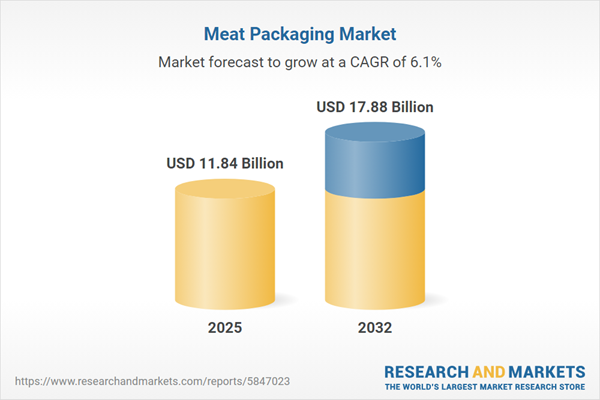Speak directly to the analyst to clarify any post sales queries you may have.
The meat packaging market is undergoing rapid change, pressured by regulatory updates, shifting sustainability demands, and evolving consumer preferences. Senior decision-makers must balance agile strategy with future-ready operations to navigate this competitive environment effectively.
Market Snapshot: Growth Outlook for the Meat Packaging Market
The Meat Packaging Market is projected to expand from USD 11.16 billion in 2024 to USD 11.84 billion in 2025, ultimately achieving USD 17.88 billion by 2032, with a CAGR of 6.07%. Growth in this sector is strongly influenced by ongoing innovation in packaging formats, greater adoption of advanced manufacturing technologies, and the continual evolution of consumer consumption patterns worldwide. As operational efficiency becomes essential, companies are investing in new business models that foster vigorous competition and set the pace for differentiated solutions. Balancing innovation with robust supply chain resilience is critical, given mounting sustainability requirements alongside operational expectations.
Scope & Segmentation
- Packaging Types: Case-ready, modified atmosphere, overwrap, skin, and vacuum packaging formats are employed to extend product shelf life, reinforce branding strategies, and offer efficient distribution solutions across channels.
- Material Types: Glass, metal, paper, paperboard, and various plastics are selected for their durability, regulatory compliance, and environmental suitability in diverse geographies.
- End User Segments: Food service, industrial, and retail organizations actively shape packaging processes to support processing efficiency, regulatory adherence, and successful marketing within B2B supply chains.
- Distribution Channels: Direct-to-consumer, e-commerce, hypermarkets, supermarkets, convenience outlets, and specialty stores demand tailored logistics and design, shaping packaging selection and adaptation for optimal performance.
- Meat Types: Fresh and processed meat categories require engineered packaging that meets rigorous safety standards and addresses the distinct needs of each sector.
- Technologies: Processes like extrusion, thermoforming, and injection molding drive the innovation of both flexible and rigid options, supporting targeted sustainable initiatives and cost-effective product development.
- Packaging Components: Essential elements such as containers, films, lids, and trays safeguard products, optimize shelf visibility, and increase practical usability for users throughout the value chain.
- Geographical Coverage: Markets across the Americas, Europe, Middle East, Africa, and Asia-Pacific are examined, each with unique regulatory climates, consumer trends, and infrastructure levels for a holistic market view.
- Company Coverage: Major firms like JBS S.A., Tyson Foods, Inc., Cargill, WH Group Limited, Pilgrim’s Pride Corporation, and Marfrig Global Foods S.A., along with additional industry leaders, are analyzed for benchmarking and supplier assessment.
Key Takeaways for Senior Decision-Makers
- Adoption of innovative packaging solutions allows companies to uphold product integrity and streamline inventory management, especially during volatile market conditions and expanding international logistics.
- Rising efforts to incorporate recyclable, compostable, and hybrid packaging materials are helping businesses synchronize with regulatory mandates and respond to an increasingly eco-aware customer base.
- Diversified sourcing and procurement strategies play a key role in mitigating supply disruptions and supporting continuity, notably in organizations with global or multi-region operations.
- Digital advancements, including automation and traceability tools, improve compliance, reinforce quality assurance, and deliver greater transparency across the production lifecycle.
- Customization of packaging formats for food service, retail, and direct channels fosters product differentiation and strengthens relationships with B2B partners.
- Varied regional regulatory frameworks prompt innovation, encouraging market players in emerging areas to develop solutions tailored to local logistics and infrastructure scenarios.
Tariff Impact on Market Dynamics
Recent U.S. tariffs on imported packaging components have caused manufacturers to reassess sourcing and operational models. A shift toward domestic and regional procurement is underway to stabilize expenses and offset supply uncertainties. The transition to alternative materials—such as paperboard, glass, and selected metals—serves to decrease reliance on tariff-imposed imports. In turn, this is prompting suppliers to revisit existing partnerships and expand capacity planning. Such adjustments are foundational for market competitiveness and supply chain resilience.
Research Methodology & Data Sources
This market analysis is underpinned by executive interviews and digital surveys as part of its primary research. Extensive secondary sources, including trade publications, regulatory reports, patent analyses, as well as government and logistics data, inform the findings and strengthen their reliability for executive planning.
Why This Report Matters
- Provides actionable segmentation, helping procurement and sustainability leaders adapt strategies to evolving supply structures.
- Equips senior management with focused regional analysis to inform investments, benchmark suppliers, and drive effective risk controls across jurisdictions.
- Offers thorough insights on regulatory influences, shifting consumer demands, and market competition, guiding both near-term and future packaging decisions.
Conclusion
By leveraging this research, executives can strengthen their market position and build operational resilience. Sustained attention to innovation and sustainability will be key as expectations continue evolving across the meat packaging market.
Additional Product Information:
- Purchase of this report includes 1 year online access with quarterly updates.
- This report can be updated on request. Please contact our Customer Experience team using the Ask a Question widget on our website.
Table of Contents
3. Executive Summary
4. Market Overview
7. Cumulative Impact of Artificial Intelligence 2025
List of Figures
Samples

LOADING...
Companies Mentioned
The key companies profiled in this Meat Packaging market report include:- JBS S.A.
- Tyson Foods, Inc.
- Cargill, Incorporated
- WH Group Limited
- Pilgrim’s Pride Corporation
- Marfrig Global Foods S.A.
- BRF S.A.
- Danish Crown AmbA
- Tönnies Holding GmbH & Co. KG
- Hormel Foods Corporation
Table Information
| Report Attribute | Details |
|---|---|
| No. of Pages | 180 |
| Published | October 2025 |
| Forecast Period | 2025 - 2032 |
| Estimated Market Value ( USD | $ 11.84 Billion |
| Forecasted Market Value ( USD | $ 17.88 Billion |
| Compound Annual Growth Rate | 6.0% |
| Regions Covered | Global |
| No. of Companies Mentioned | 11 |









